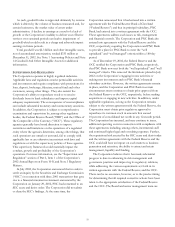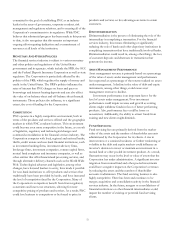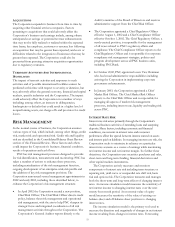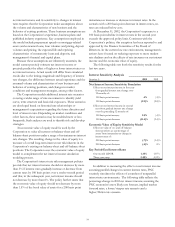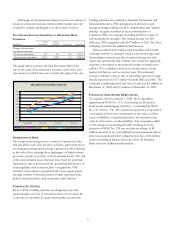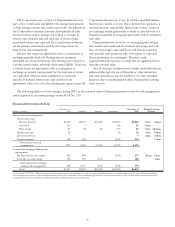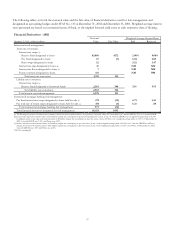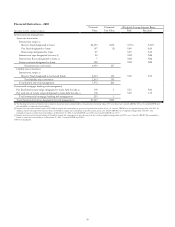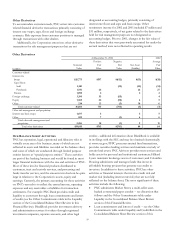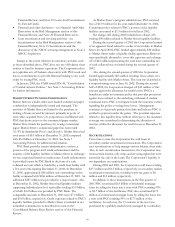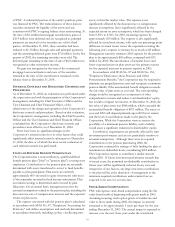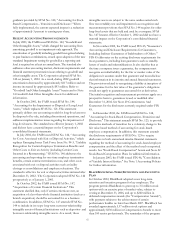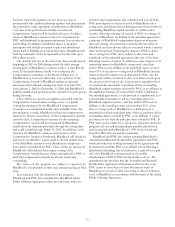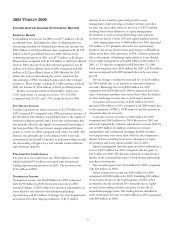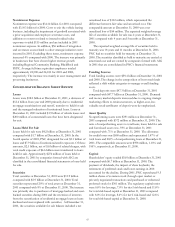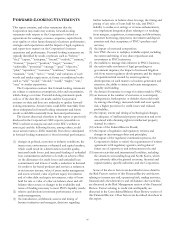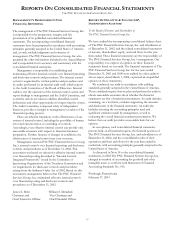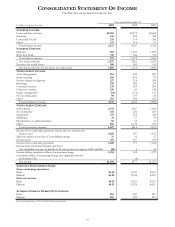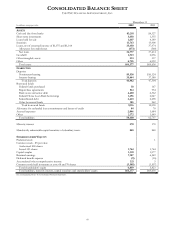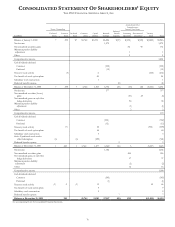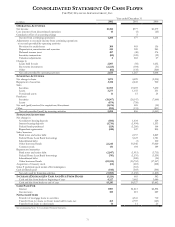PNC Bank 2002 Annual Report Download - page 63
Download and view the complete annual report
Please find page 63 of the 2002 PNC Bank annual report below. You can navigate through the pages in the report by either clicking on the pages listed below, or by using the keyword search tool below to find specific information within the annual report.61
of PNC. A substantial portion of the entity’s purchase price
was financed by PNC. The reclassification of these loans to
securities increased the liquidity of the assets and was
consistent with PNC’s ongoing balance sheet restructuring. At
the time of the residential mortgage securitization, gains of
$25.9 million were deferred and are recognized as principal
payments are received or the securities are sold to third
parties. At December 31, 2001, these securities had been
reduced to $1.3 billion through sales and principal payments
and the remaining deferred gains were $7.8 million. In the first
quarter of 2002, the remaining securities were sold. The
deferred gain remaining at the time of sale of $6.0 million was
recognized as other noninterest income.
No gain was recognized at the time of the commercial
mortgage loan securitization and none of the securities
retained at the time of the securitization remained on the
balance sheet at December 31, 2001.
INTERNAL CONTROLS AND DISCLOSURE CONTROLS AND
PROCEDURES
As of December 31, 2002, an evaluation was performed under
the supervision and with the participation of the Corporation’s
management, including the Chief Executive Officer and the
Vice Chairman and Chief Financial Officer, of the
effectiveness of the design and operation of the Corporation’s
disclosure controls and procedures. Based on that evaluation,
the Corporation’s management, including the Chief Executive
Officer and the Vice Chairman and Chief Financial Officer,
concluded that the Corporation’s disclosure controls and
procedures were effective as of December 31, 2002.
There have been no significant changes in the
Corporation’s internal controls or in other factors that could
significantly affect internal controls subsequent to December
31, 2002, the date as of which the most recent evaluation of
such internal controls was performed.
STATUS OF DEFINED BENEFIT PENSION PLAN
The Corporation has a noncontributory, qualified defined
benefit pension plan ("plan" or "pension plan") covering most
employees. Contributions to the pension plan are actuarially
determined with assets transferred to a trust to fund benefits
payable to plan participants. Plan assets are currently
approximately 60% invested in equity investments with most
of the remainder invested in fixed income instruments. Plan
investment strategy is determined and reviewed by plan
fiduciaries. On an annual basis, management reviews the
actuarial assumptions related to the pension plan, including the
discount rate, rate of compensation increase and the expected
return on plan assets.
The expense associated with the pension plan is calculated
in accordance with SFAS No. 87, "Employers' Accounting for
Pensions," and utilizes assumptions and methods determined
in accordance therewith, including a policy of reflecting trust
assets at their fair market value. The expense is not
significantly affected by the discount rate or compensation
increase assumptions, but is significantly affected by the
expected return on asset assumption, which has been changed
from 9.50% to 8.50% for 2003, increasing expense by
approximately $10 million. The expense is also significantly
affected by actual trust returns, with each one percentage point
difference in actual return versus the expectation causing the
following year’s expense to increase by as much as $2 million.
Management currently estimates 2003 expense for the pension
plan to be approximately $50 million, compared with $15
million for 2002. The amortization of actuarial losses and
lower expected return on plan assets are the primary reasons
for the expected increases in pension expense in 2003.
In accordance with SFAS No. 87 and SFAS No. 132,
"Employers' Disclosures about Pensions and Other
Postretirement Benefits," the Corporation may be required to
eliminate any prepaid pension asset and recognize a minimum
pension liability if the accumulated benefit obligation exceeds
the fair value of plan assets at year-end. The corresponding
charge would be recognized as a component of other
comprehensive income and reduce total shareholders' equity,
but would not impact net income. At December 31, 2002, the
fair value of plan assets was $966 million, which exceeded the
accumulated benefit obligation of $871 million. The status at
year-end 2003 will depend primarily upon 2003 trust returns
and the level of contributions made to the plan by the
Corporation. While the Corporation views as remote the
possibility of a minimum pension liability, such a liability
would cause a significant reduction in shareholders’ equity.
Contribution requirements are primarily affected by trust
investment performance and are not particularly sensitive to
actuarial assumptions. Although there were no required
contributions to the pension plan during 2002, the
Corporation continued its strategy of fully funding the plan at
maximum tax-deductible levels, contributing $210 million.
The Corporation expects to contribute a similar amount
during 2003. If future investment performance exceeds that
of recent years, the permitted tax-deductible contribution in
future years will be significantly reduced. In any case and
irrespective of any factors, any large near-term contributions
to the plan will be at the discretion of management as the
minimum required contributions under current law are
expected to be zero for several years.
STOCK-BASED COMPENSATION
PNC will expense stock-based compensation using the fair
value-based method, beginning with grants made in 2003.
Assuming recurring stock option grants of similar size and
value to those made during 2002, this impact is currently
estimated to be approximately 5 cents per share for the year
ending December 31, 2003. The annual impact is expected to
increase over the next three years under the transitional


